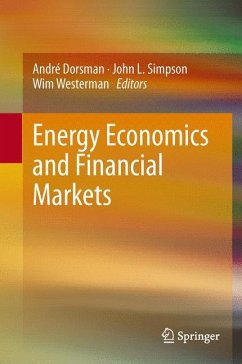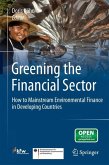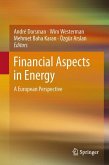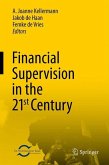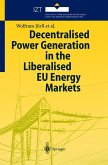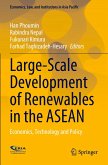Energy issues feature frequently in the economic and financial press. Specific examples of topical energy issues come from around the globe and often concern economics and finance. The importance of energy production, consumption and trade raises fundamental economic issues that impact the global economy and financial markets. This volume presents research on energy economics and financial markets related to the themes of supply and demand, environmental impact and renewables, energy derivatives trading, and finance and energy. The contributions by experts in their fields take a global perspective, as well as presenting cases from various countries and continents.
BOOK REVIEW
Energy Economics and Financial Markets
Edited by Andre Dorsman. John L. Simpson and Wim Westerman
Springer, ISBN 978-3-642-30600-6
Summary
This book provides a collection of research papers on energy issues in financial economics. The book covers a wide range of aspects of energy economics from both micro and macroeconomic points of view. The issues covered in the book include those related to consumption and production of energy, environmental impact of energy, the interactions between energy and growth, and energy pricing. The discussions and findings presented in the book provide important insights into various current energy issues which may be of interest not only to policy makers but also to practitioners in the public and private sector. The book clearly shows the relevance of recent academic research in a growing area in the literature.
Coverage
The book comprises four parts which focus on different aspects energy economics and financial markets, combining both general and specific research issues. In this respect, it appeals to both an audience with general interest on the subject and researchers in economics and finance with a specific focus on the topic of energy. Each part comprises of three chapters. In the following, I provide a summary of each chapter and then give an overall conclusion.
In Part I of the book, the issues related to supply and demand of energy are covered. The first chapter of this part considers the vulnerability of the world's economy to the risks associated with demand and supply conditions of natural gas. To do so, the study develops a composite gas supply security index (GSSI) for a group of Asian countries. The main finding of the analysis is that there are differences across countries with respect to their vulnerability to natural gas supply disruptions. There are hence important policy implications the study advocates in terms of minimising the costs associated with adverse changes. Among the measures governments can take are diversification in fuel types, reduction in overall gas dependence through R&D and adoption of efficient technologies, and increased efforts to facilitate gas exploration and production. The second chapter in this part of the book addresses the effects of risk factors in determining the buyer credit premium. The main risk factor considered in the study in this respect is country risk. Borrowing from the traditional finance literature on the risk-return relation and portfolio analysis, the study suggests that credit providers, in addition to the issues related to shareholder maximisation, should also pay attention to diversifying away the unsystematic risks including the country-specific risk. Finally, the third chapter in this part investigates the determinants of energy consumption for a large sample of developing countries. After providing a useful literature survey, the study carries out several statistical causality tests to establish the link between energy consumption in about 30 countries and population, growth, inflation and CO2 emission. It is shown that the strongest causality tests belong to total population and CO2 emission.
In Part II, the environmentalissues and renewables are addressed. The three studies included in this part raise different but related aspects of the interactions between energy consumption and environment. In the first study, the relationship between GDP growth and CO2 emissions is analysed with a specific focus on the impact of the consumption of fossil fuel and renewable energy consumption on this relation. It is found that renewable energy production reduces the use of fossil fuel. However, it has a negative impact on economic growth at least in the medium-term due to the fixed costs involved in renewable energy production. The findings of the study lead to an interesting future research agenda. The analysis of the following chapter provides a theoretical discussion on carbon pricing for tackling climate change by analysing the merits of taxes and tradable permits. Although the study is inconclusive regarding the choice of one instrument over the other, it provides a useful analysis in presenting the problems and issues associated with each policy. In particular, it gives a useful summary as to the uncertainty surrounding the costs and distributional consequences of emissions trading schemes which have a relatively short history. The last chapter in this part of the book is also on the emissions trading scheme with a focus on the impact of price changes of European Union Emission Allowances EUAs) on stock returns of a sample of European firms. The novel approach of the study is to combine EUA price changes with firm-specific factors in determining stock returns. The findings suggest there is generally a positive relation between EUA price changes and stock returns and firm-specific factors do not affect the relationship. Also importantly, the empirical analysis suggests that the relation between emission allowances and returns vary across different sub-periods.
Part III shifts the attention to the financial issues by focusing on the dynamics of the energy derivatives. The first chapter investigates if the market dynamics of the EU Emissions Trading Scheme (EU ETS) options and futures display similar characteristics to those of commodity markets. For comparison purposes, the West Texas Intermediate (WTI) crude oil derivatives market is considered as a benchmark. The study provides several useful insights. In particular, the results suggest that both the futures and options markets are mature with similar price and volatility behaviour, which is consistent with other commodity derivatives markets. This is taken as evidence to argue that the EU has been successful in establishing of the ETS derivatives markets despite the difficulties encountered in the early stages of both the futures and options markets. The second chapter in this part of the book continues in a similar manner by examining the relation between future and spot prices for crude oil. The study first provides a useful survey and a theoretical basis to test the relation. In an attempt to provide further insights in the literature that provides mixed findings, the study extends prior empirical work to provide evidence that future crude oil prices do not have much predictive power for spot prices. The study hence raises further doubts as to the use of similar models to predict spot oil prices and advocates caution. The last chapter carries a comparative empirical analysis to examine the degree of decoupling of oil and gas markets and deregulation of the gas sector in the US and UK markets. The study provides evidence in support of the view that US markets are more decoupled than UK markets. Also, domestic forces in gas price expectations are significant in impacting the relation between the future and spot gas prices globally. The study cannot provide any such evidence for the UK markets. It is hence argued that deregulation policies in the US have been more effective compared to the UK.
The final part of the book, Part IV, deals with the energy issues that are related to more mainstream finance. The first chapter investigates if the risk-return trade off can be improved by adding oil to a portfolio of stock and bonds. It is found that the trade-off can be improved mainly due to the counter cyclicality of oil returns. Furthermore, the findings suggest that while oil is not a hedge for shareholders it is for bondholders. Overall, it is concluded that oil is not a safe haven for stockholders and bondholders. The following chapter considers the imperfections in electricity networks for a number of European countries to investigate the impact of market coupling on the energy price risk. It is found that market coupling that links the former nationally organised markets does indeed reduce the volatility of the energy prices and hence the price differences between the markets. The study provides important insights and leads to an overall conclusion that more integrated European electricity networks would create a market with increased price efficiencies. Finally, the last chapter examines energy initial public offerings (IPOs) in Australia. It is found that the extent of underpricing in energy IPOs is significant. The study does not offer any explanations that are specific to energy IPOs. However, it seems that the energy market is also subject to the imperfections, such as asymmetric information between the issuer, underwriter and investor, which lead to higher returns for investors who are able to register with new issues and sell them on the first trading day.
Conclusions
In summary, this book is a very good piece of scholarly work that covers important aspects of energy. The book is timely and provides an excellent overall view as wellas a specific investigation into a number of issues that are covered frequently in the economic and financial press. It strikes a good balance between academic rigour and a more practical and policy oriented approach. In doing so, it achieves to reach a wider audience and can be used by academic researchers, lecturers, policy makers and practitioners. In addition to providing useful insights into the relevant energy issues, each chapter also sets out the future policy and research agenda on energy.
AYDIN OZKAN University of Hull, UK
Energy Economics and Financial Markets
Edited by Andre Dorsman. John L. Simpson and Wim Westerman
Springer, ISBN 978-3-642-30600-6
Summary
This book provides a collection of research papers on energy issues in financial economics. The book covers a wide range of aspects of energy economics from both micro and macroeconomic points of view. The issues covered in the book include those related to consumption and production of energy, environmental impact of energy, the interactions between energy and growth, and energy pricing. The discussions and findings presented in the book provide important insights into various current energy issues which may be of interest not only to policy makers but also to practitioners in the public and private sector. The book clearly shows the relevance of recent academic research in a growing area in the literature.
Coverage
The book comprises four parts which focus on different aspects energy economics and financial markets, combining both general and specific research issues. In this respect, it appeals to both an audience with general interest on the subject and researchers in economics and finance with a specific focus on the topic of energy. Each part comprises of three chapters. In the following, I provide a summary of each chapter and then give an overall conclusion.
In Part I of the book, the issues related to supply and demand of energy are covered. The first chapter of this part considers the vulnerability of the world's economy to the risks associated with demand and supply conditions of natural gas. To do so, the study develops a composite gas supply security index (GSSI) for a group of Asian countries. The main finding of the analysis is that there are differences across countries with respect to their vulnerability to natural gas supply disruptions. There are hence important policy implications the study advocates in terms of minimising the costs associated with adverse changes. Among the measures governments can take are diversification in fuel types, reduction in overall gas dependence through R&D and adoption of efficient technologies, and increased efforts to facilitate gas exploration and production. The second chapter in this part of the book addresses the effects of risk factors in determining the buyer credit premium. The main risk factor considered in the study in this respect is country risk. Borrowing from the traditional finance literature on the risk-return relation and portfolio analysis, the study suggests that credit providers, in addition to the issues related to shareholder maximisation, should also pay attention to diversifying away the unsystematic risks including the country-specific risk. Finally, the third chapter in this part investigates the determinants of energy consumption for a large sample of developing countries. After providing a useful literature survey, the study carries out several statistical causality tests to establish the link between energy consumption in about 30 countries and population, growth, inflation and CO2 emission. It is shown that the strongest causality tests belong to total population and CO2 emission.
In Part II, the environmentalissues and renewables are addressed. The three studies included in this part raise different but related aspects of the interactions between energy consumption and environment. In the first study, the relationship between GDP growth and CO2 emissions is analysed with a specific focus on the impact of the consumption of fossil fuel and renewable energy consumption on this relation. It is found that renewable energy production reduces the use of fossil fuel. However, it has a negative impact on economic growth at least in the medium-term due to the fixed costs involved in renewable energy production. The findings of the study lead to an interesting future research agenda. The analysis of the following chapter provides a theoretical discussion on carbon pricing for tackling climate change by analysing the merits of taxes and tradable permits. Although the study is inconclusive regarding the choice of one instrument over the other, it provides a useful analysis in presenting the problems and issues associated with each policy. In particular, it gives a useful summary as to the uncertainty surrounding the costs and distributional consequences of emissions trading schemes which have a relatively short history. The last chapter in this part of the book is also on the emissions trading scheme with a focus on the impact of price changes of European Union Emission Allowances EUAs) on stock returns of a sample of European firms. The novel approach of the study is to combine EUA price changes with firm-specific factors in determining stock returns. The findings suggest there is generally a positive relation between EUA price changes and stock returns and firm-specific factors do not affect the relationship. Also importantly, the empirical analysis suggests that the relation between emission allowances and returns vary across different sub-periods.
Part III shifts the attention to the financial issues by focusing on the dynamics of the energy derivatives. The first chapter investigates if the market dynamics of the EU Emissions Trading Scheme (EU ETS) options and futures display similar characteristics to those of commodity markets. For comparison purposes, the West Texas Intermediate (WTI) crude oil derivatives market is considered as a benchmark. The study provides several useful insights. In particular, the results suggest that both the futures and options markets are mature with similar price and volatility behaviour, which is consistent with other commodity derivatives markets. This is taken as evidence to argue that the EU has been successful in establishing of the ETS derivatives markets despite the difficulties encountered in the early stages of both the futures and options markets. The second chapter in this part of the book continues in a similar manner by examining the relation between future and spot prices for crude oil. The study first provides a useful survey and a theoretical basis to test the relation. In an attempt to provide further insights in the literature that provides mixed findings, the study extends prior empirical work to provide evidence that future crude oil prices do not have much predictive power for spot prices. The study hence raises further doubts as to the use of similar models to predict spot oil prices and advocates caution. The last chapter carries a comparative empirical analysis to examine the degree of decoupling of oil and gas markets and deregulation of the gas sector in the US and UK markets. The study provides evidence in support of the view that US markets are more decoupled than UK markets. Also, domestic forces in gas price expectations are significant in impacting the relation between the future and spot gas prices globally. The study cannot provide any such evidence for the UK markets. It is hence argued that deregulation policies in the US have been more effective compared to the UK.
The final part of the book, Part IV, deals with the energy issues that are related to more mainstream finance. The first chapter investigates if the risk-return trade off can be improved by adding oil to a portfolio of stock and bonds. It is found that the trade-off can be improved mainly due to the counter cyclicality of oil returns. Furthermore, the findings suggest that while oil is not a hedge for shareholders it is for bondholders. Overall, it is concluded that oil is not a safe haven for stockholders and bondholders. The following chapter considers the imperfections in electricity networks for a number of European countries to investigate the impact of market coupling on the energy price risk. It is found that market coupling that links the former nationally organised markets does indeed reduce the volatility of the energy prices and hence the price differences between the markets. The study provides important insights and leads to an overall conclusion that more integrated European electricity networks would create a market with increased price efficiencies. Finally, the last chapter examines energy initial public offerings (IPOs) in Australia. It is found that the extent of underpricing in energy IPOs is significant. The study does not offer any explanations that are specific to energy IPOs. However, it seems that the energy market is also subject to the imperfections, such as asymmetric information between the issuer, underwriter and investor, which lead to higher returns for investors who are able to register with new issues and sell them on the first trading day.
Conclusions
In summary, this book is a very good piece of scholarly work that covers important aspects of energy. The book is timely and provides an excellent overall view as wellas a specific investigation into a number of issues that are covered frequently in the economic and financial press. It strikes a good balance between academic rigour and a more practical and policy oriented approach. In doing so, it achieves to reach a wider audience and can be used by academic researchers, lecturers, policy makers and practitioners. In addition to providing useful insights into the relevant energy issues, each chapter also sets out the future policy and research agenda on energy.
AYDIN OZKAN University of Hull, UK

